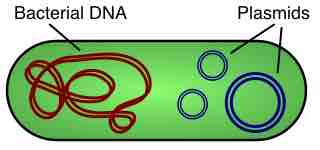The study of microbial pathogens with genetic methods is a new and explosive field set to dominate microbiology in the next decade. Microbes provide an excellent starting point for genetic studies because they have a relatively simple genomic structure compared to higher, multicellular organisms.
Microbial Genomes
Studies on microbial genomes may provide crucial starting points for understanding the genomics of higher organisms. There are 32 microbial genomes sequenced to date and published (25 domain Bacteria, 5 Domain Archaea, 1 domain Eukarya).
Relationship between Bacteria and Plasmids
Bacteria obey the laws of genetics and the central dogma of life. DNA that carries genetic information is transcribed to RNA polypeptides, which are translated into protein. Viruses differ from other microbes as they can carry either DNA or RNA. Cell function depends on specific polypeptides, proteins, and enzymes encoded by genes. Bacterial chromosomes contain double stranded molecules of DNA arranged in a circular form called plasmids .

Circular Plasmid DNA
Plasmid DNA that can replicate independently of chromosomal DNA.
Plasmids are located in the cytoplasm of bacteria, are capable of autonomous replication, and transfer genes from parent cell to daughter cell. Bacteria possess extra chromosomal genetic elements that encode for antibiotic resistance, toxins, virulence determining genes, and reduced sensitivity to mutagens such as heavy metals. Plasmid profiling using molecular, biochemical, and microbial techniques is essential to understanding the mechanism of pathogenicity and to fuel genetic engineering.
Techniques to Study Genomes
Many of the techniques used to study whole genomes are conventional molecular biology techniques adapted to operate effectively with DNA in a much larger size range. Pulsed field gel electrophoresis (PFGE) is an adaptation of conventional agarose gel electrophoresis that allows extremely large DNA fragments to be resolved (up to megabase size fragments). PFGE is essential for estimating the sizes of whole genomes/chromosomes prior to sequencing and is necessary for preparing large DNA fragments for large insert DNA cloning and analysis of subsequent clones. It is a commonly used and extremely powerful tool for genotyping and epidemiology studies for pathogenic microorganisms. DNA cloning is another technique fundamental to molecular biology that requires adaptation in order to be useful in studying DNA at a whole genome scale.
There are two main approaches to sequencing microbial genomes – the ordered clone approach and direct shotgun sequencing both require large and small insert genomic DNA libraries in order to be effective.
Microarray hybridization is another technique used to characterize the dynamic nature of gene expression within a microbial cell. Microarray technology allows whole organism gene expression to be investigated. PCR products of every gene from a complete genome sequence are bound in a high-density array on a glass slide. These arrays are probed with fluorescently labeled cDNA prepared from whole RNA under specific environmental conditions. The level of cDNA is then quantified using high-resolution image scanners.
These techniques allow the identification of the genotype (i.e.-the genetic makeup) of a cell. Genotypic variations exist in microbes and these include mutations, gene transfer by transformation, conjugation, and transduction.
Mutation
Mutation is random, undirected, heritable variation caused by alteration in nucleotide sequence at some point of DNA. Mutations can take the form of deletion, addition, or substitution of one or more bases. All genes are susceptible to mutations, but not all mutations are expressed. Genetic analysis of microbes allows the characterization of genes implicated in microbial pathogenesis.